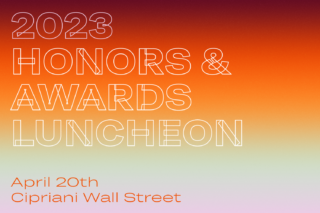
The Spring issue is a time when the editorial staff gets to take a different approach to the magazine, assuming a passenger seat on the journey piloted by that year’s Design Awards jury. Beginning the year before, the call for submissions goes out, and on a usually chilly day in early January, a group of jurors gathers to pore over pages of descriptive text, photography, and technical information (which has already been vetted by a specialized panel in a rigorous technical-review process prior to submissions being sent to the jury).
In 2023, we celebrate 18 Design Awards winners, selected from 180 submissions by 119 firms. Though all are built or planned for New York City, or designed by New York-based architects, their reach is clearly global. It is exciting to see new approaches to designing a public school, on a public-school budget, to WELL standards; to building a symbiotic relationship between commercial and residential structures; and to creating new pathways and opportunities for engagement within campuses or busy city streets.
This year’s jury sought out architecture that was in service of the public realm. “It’s not enough for a building to serve just its initial program use,” said juror Gia Biagi, commissioner of the Chicago Department of Transportation, at the Design Awards Jury Symposium in January. “In a city we own so many things in common—30% to 50% of the land area in a city is owned in common—streets, parks, alleys. All architecture must touch the ground some-where. We have to think about how that context presses on the potential of the project, and how the project presses back.”
The jury agreed that if this year’s projects have a theme, it was going beyond their property lines to become meaningful additions to surrounding communities. The thresholds between public and private spaces are dissolved in even the smallest and yet-to-be realized among this year’s award recipients, the Barco de Papel Librería y Centro Cultural, New York’s only surviving Spanish-language literature bookstore, designed by N H D M Architects. Extending its façade and seating into the street, the shop shows us the mutually beneficial move of a private entity putting out a welcome mat for the public. We hope you draw as much inspiration from these projects as the jury and we, the editors, did this year!
As we reflect back on the past year’s noteworthy work, it is also time to make plans for the remainder of the year ahead, and what we can bring to the pages of this magazine. The Summer issue will be devoted to K–12 educational spaces and the question of how architects are creating better learning environments not just for children, but also for their educators and communities. In the Fall, we will devote the magazine to exploring the use of materials in architecture. Following press time in March, I plan to attend the Design for Freedom 2023 Summit at Grace Farms, part of the organization’s ongoing work to remove forced labor from the building materials supply chain. This discussion is just one of many advancing the role of architecture in creating a more equitable world—a conversation that inevitably begins at home but has global implications, especially as the nations of Syria, Turkey, and Ukraine each contemplate huge rebuilding efforts. For different reasons, these represent massive humanitarian crises and vast losses for communities in terms of secure built environments, not to mention a sense of place. So, while this issue focuses on work created close to our NYC home, we look forward to seeing how its themes and teachings will go on to have global impact.













